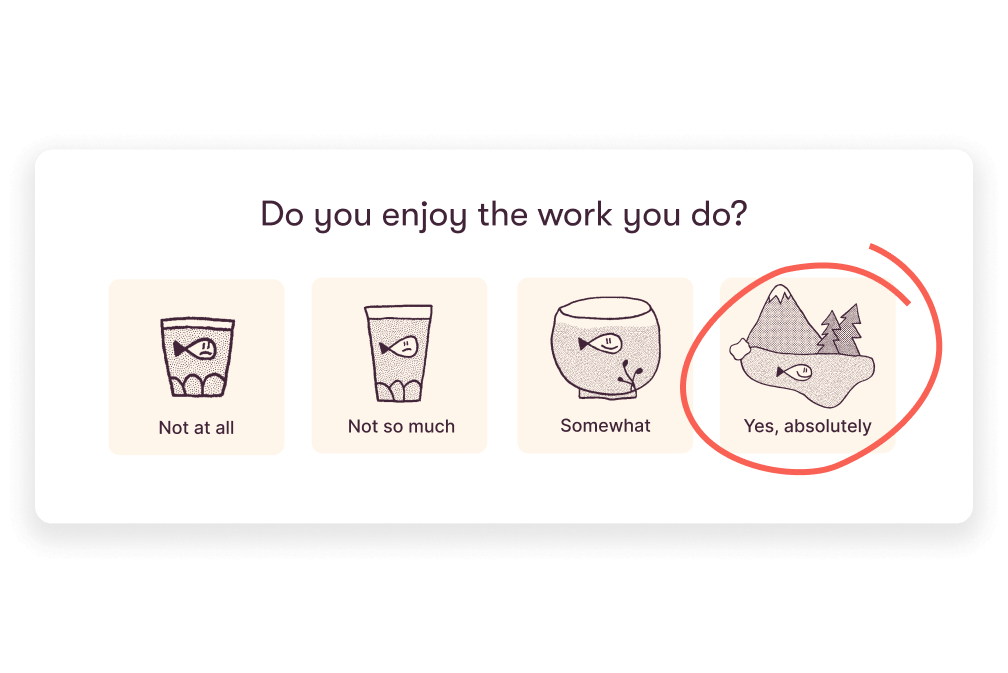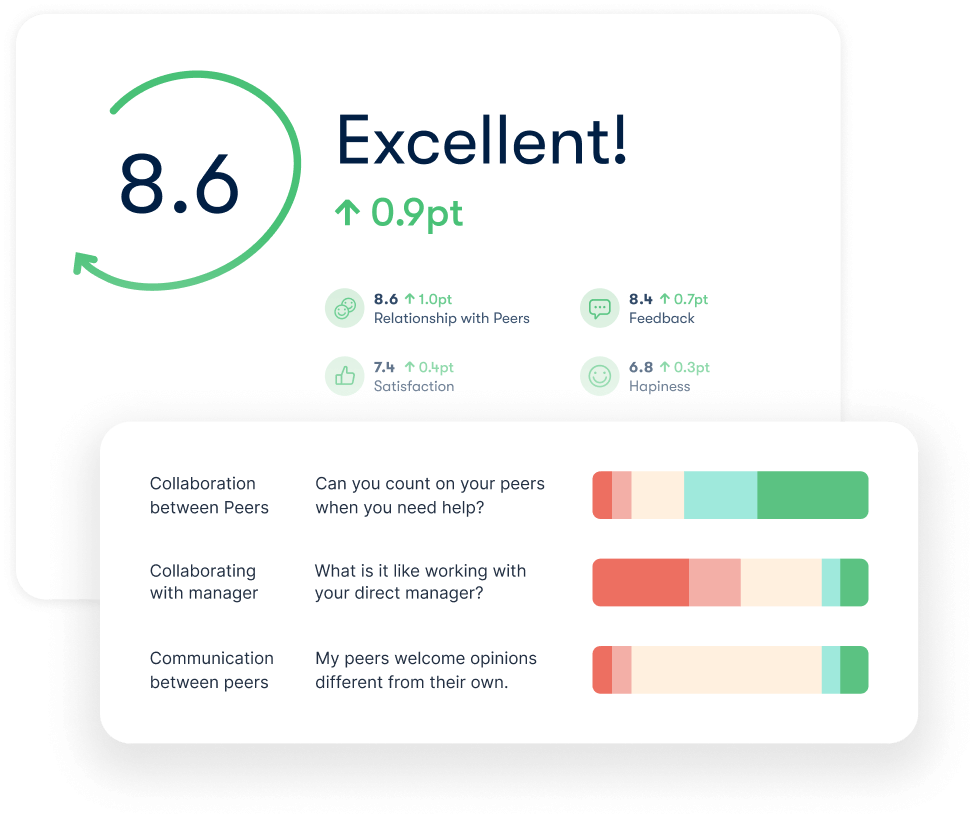The use of employee surveys is growing dramatically, and with good reason—they work!
Companies with engaged employees are 21% more productive than those who feel dispassionately about their work, so making sure your team feels challenged, appreciated, and stimulated can make all the difference in opening communications channels, reducing unfortunate employee turnover, and hitting your numbers.
But how can we measure employee engagement? An excellent way to gauge how your team is feeling is by utilizing tools like employee engagement surveys. Let’s look at some of their benefits and how you can use employee engagement surveys to foster a productive and inclusive workplace culture.
Assess your organization’s employee experience in minutes

What is measured in employee engagement surveys?
Why are employee engagement surveys important?
Stephen Covey, bestselling author of ‘The 7 Habits of Highly-Effective People,’ said: “People are your most important asset.” He was right on the money.
Not only are employees the heart of any organization, but the costs associated with finding new talent can be staggering. The Work Institute estimates that replacing an employee can cost a company upwards of 30% of that person's annual salary.
While retaining quality employees makes sense financially, it also fosters a consistent workflow essential to any organization.
Engagement surveys are important because they are your key to turning things around. When you implement feedback surveys correctly, you can assess employee sentiment to see what you are doing right and what you might need to improve.
Using engagement surveys, you can get deep insights into the quality and nature of your team members’:
- Relationships with managers
- Relationships with colleagues
- Job satisfaction
- Feelings about pay, benefits, and working conditions
- Expectations of career development
- Motivation to succeed
- Feelings about the organization
- Satisfaction with training and support
Without this tangible data, you might not be aware of potential roadblocks to your organization’s success. But when you have all the information and insights you need at your fingertips, you are in a position to leverage your greatest asset and turn your workforce into a productivity powerhouse.
How do employee surveys work?
There are many ways to conduct employee surveys. You can opt for traditional methods like sending email questionnaires to employees and compiling results in a spreadsheet.
Although it’s better than not checking in with your team at all, it’s not the most efficient way of going about it; crucial information can slip through the cracks defeating the survey’s original purpose. And who wants to manage multiple spreadsheets over time? Fortunately, there’s a better way to measure employee engagement.
Nowadays, you can take advantage of software that solves this problem. Employee engagement survey software provides you with an easy way to take the pulse of team sentiment and gain a wealth of valuable feedback.
These tools automate the process of surveying employees, asking them questions on a range of issues important to managers. Team members can provide feedback anonymously, and managers can analyze the results to ascertain trends and areas of concern.
With Officevibe’s Pulse Survey Tool, for example, the data helps managers understand:
- What is working in your organization (and what’s not)
- Where people need support
- The impact of initiatives and projects
Employees benefit from having an easy way to express their feelings, with their privacy protected by anonymity. Managers gain an array of detailed feedback they can explore for better understanding. See which Officevibe employee engagement survey suits your team best.
What do employee surveys actually measure?
Although every employee feedback tool works in its own way, there are themes that are common to most of them. Here are examples of the key metrics that most tools measure and which you should prioritize:
Employee satisfaction
Job satisfaction has been directly linked to higher productivity, so focusing this crucial metric makes sense.
Employee engagement survey questions regarding job satisfaction focus mainly on the perceptions and opinions of team members. These may cover salary, benefits, working hours, and company policies.
Employee morale
If you’re looking for a barometer of team health, then employee morale is probably it. A team with good enthusiasm is likely to be effective and efficient. But if morale starts to slide, productivity can take a nosedive.
Monitoring team morale is especially significant when big changes arise, like during an office move or merger.
How managers perform
According to Officevibe’s recent data report on the state of employee experience, only 25% of employees feel like the feedback they receive from their managers is frequent enough to help them understand how to improve their performance.
So employee engagement surveys help managers better perform their jobs and build stronger relationships with team members.
Access to survey data empowers managers to make more informed decisions, making them more effective in their roles.
How teams compare
Employee surveys can be beneficial in drawing attention to disparities within your organization.
You may find that a team in one location performs considerably better than their counterparts elsewhere. Or, for example, you might discover that your marketing team is productive while your accounts people struggle.
Once these issues have been highlighted, you can take action to address the root cause.
How do Officevibe surveys measure employee engagement?
At Officevibe, we believe you need to go deep in measuring employee engagement accurately. Officevibe’s Pulse Surveys pull their questions from a bank of 120 questions. Each question is related to one of our 10 Key Metrics of Engagement, then subdivided into 26 Sub-Metrics, selected to highlight the most important themes within any given metric.

These metrics are based on our years of research in employee experience and partnering with other experts in the field, like Deloitte, to test and confirm the scientific validity of our survey model against recognized and supported theories. Scores are calculated for each team and department all up to the company level. Officevibe sends different survey questions every week to monitor all 10 metrics continuously.
Here’s what these 10 Key Metrics of Engagement measure:
Recognition
It’s vital that employees feel appreciated and recognized when they go the extra mile.The Recognition metric represents both the quality and the frequency of recognition received by team members.
Feedback
Feedback is a two-way process. Employees need to receive feedback on their efforts and have the opportunity to voice their opinions to management.
The Feedback metric measures the quality and frequency of feedback to ensure that each part of the exchange runs smoothly.
Happiness
Naturally, you want your employees to be happy at work. But you can’t make assumptions and leave this to chance.
The Happiness metric gauges team members levels of happiness at work. It also reveals whether employees feel a sense of accomplishment and fulfillment from their work.
Personal growth
Your team's continuous professional development is critical to building strong morale and future leaders. The Personal Growth metric represents the level of autonomy, mastery, and purpose of role.
Satisfaction
Happy employees feel comfortable with the way they are treated in the workplace. With this in mind, the Satisfaction metric represents the perception of fair pay, performance practices, work environment, and role.
Wellness
Today’s leading organizations understand the importance of genuinely connecting and caring for their employees. The Wellness metric measures the level of stress and perception of support for healthy life habits.
Ambassadorship
When team members become willing ambassadors for your business, you know you are on the road to success. So how likely are your employees to talk positively about your company? You need to know the answer to this question.
Fortunately, this is what the Ambassadorship metric reveals. It represents the pride in and likeliness to recommend the organization as a place to work.
Relationship with manager
Every employee needs and deserves a good relationship with their manager. When problems arise in this area, they need to be addressed quickly.
The Relationship with manager metric is concerned with trust and communication. It also sizes up collaboration between employees and their managers.
Relationship with peers
For a healthy working environment to flourish, employees should get on well with their colleagues. When problems arise in this area, they are often invisible to managers. That makes careful measurement especially important.
The Relationship with peers metric shows insights into trust, communication, and collaboration between peers which will help you develop a healthy workplace culture.
Alignment
As well as being hard-working and productive, team members must be a good fit with the organization’s vision. If there is a gap between the company’s mission and an employee’s worldview, that may lead to problems.
The Alignment metrics represents team members' alignment with the organization's values, plus the perception of ethical and social responsibilities.
What to do with your employee survey results?
Thanks to tools like Officevibe, it’s now easier than ever to conduct employee engagement surveys. But there’s no point in gathering data unless you use to become a more responsive leader who can make and act on informed decisions. The result is a sure boost to employee engagement. This information can give you a real competitive edge when used intentionally, so it makes sense to leverage it to the fullest.
Employee survey results analysis allows you to uncover issues you must address, and pinpoint exemplary behavior to reinforce. You can then design a plan to take action and execute this as quickly as possible.

Be sure to share these actions with your team to let them know that their feedback is useful and appreciated. Make collecting feedback an ongoing process to help you gain continuous, incremental improvement in how your teams operate.
Discover the benefits of engaged employees
There’s a simple way to discover the many advantages of employee survey tools: try one for yourself! Sign up for a Pulse Survey tool like Officevibe and get your first employee engagement survey underway.
Thanks to the insights gathered by these employee engagement surveys, you’ll be able to make informed decisions and take steps toward building a more engaged team where everyone succeeds.
Equip HR and managers with tools to engage, recognize, and drive performance.




